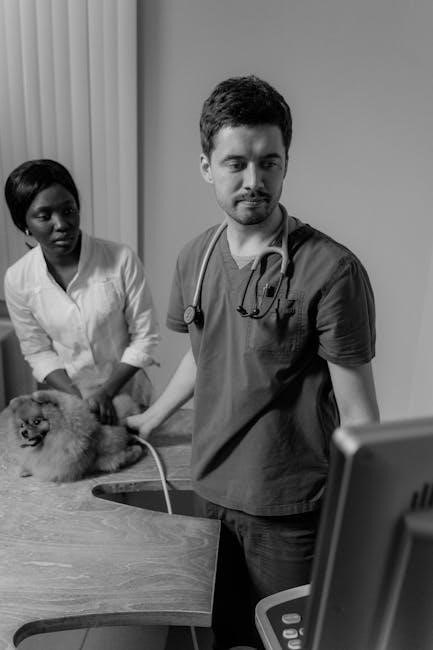Medical Assistant Curriculum PDF: A Comprehensive Guide
Are you ready to explore the world of medical assisting? This guide provides a detailed primer on the education and certification requirements for becoming a certified medical assistant. It will outline program outcomes, career opportunities, and curriculum information.
What is a Medical Assistant? Roles and Responsibilities
A certified medical assistant (CMA) is a vital healthcare professional, working alongside doctors and nurses to provide comprehensive patient care. Their roles are diverse, encompassing both clinical and administrative duties within various healthcare settings like medical offices, clinics, and hospitals.
On the clinical front, CMAs directly interact with patients. This includes taking vital signs such as blood pressure and temperature, preparing patients for examinations, and assisting with procedures. They may also perform phlebotomy (drawing blood) for lab tests and administer injections, depending on state regulations and training.
Administratively, CMAs handle tasks like scheduling appointments, managing patient records, and processing insurance claims. They ensure smooth office operations, allowing healthcare providers to focus on patient treatment.
The versatility of a CMA makes them indispensable members of the healthcare team. They bridge the gap between clinical and administrative functions, contributing to efficient and patient-centered care. Their ability to adapt to different roles and responsibilities makes them highly sought after in the healthcare industry.
CMAs play a crucial role in patient care, assisting with vital tasks and helping to create a comfortable and efficient environment. They are a key part of the medical team, helping patients every day.
Educational Requirements: High School Diploma and Beyond
The first step towards a career as a medical assistant is typically obtaining a high school diploma or its equivalent, such as a GED. While a high school diploma serves as the foundational educational requirement for most medical assistant programs, further education and training significantly enhance career prospects;
Although some medical assistants enter the field directly with a high school diploma, completing a formal medical assistant program is highly recommended. These programs, offered at vocational schools, community colleges, and universities, provide comprehensive training in both clinical and administrative skills.
Pursuing a certificate, diploma, or associate degree in medical assisting can greatly improve job competitiveness and earning potential. A medical assistant with a college degree may be more competitive against other candidates, and their education may help them to qualify for a higher salary.
These programs cover essential topics such as medical terminology, anatomy, physiology, patient care, medical office procedures, and electronic health records. Additionally, they often include hands-on training through clinical externships, providing real-world experience in a medical setting.
For those seeking advanced career opportunities, a bachelor’s degree in a related field, such as healthcare administration, may be beneficial. This can open doors to supervisory or management positions within healthcare organizations.
Accredited Medical Assistant Programs: ABHES and CAAHEP
Accreditation plays a pivotal role in ensuring the quality and credibility of medical assistant programs. For aspiring Certified Medical Assistants (CMAs), graduating from an accredited program is often a prerequisite for certification eligibility.
Two primary accrediting bodies for medical assistant programs are the Accrediting Bureau of Health Education Schools (ABHES) and the Commission on Accreditation of Allied Health Education Programs (CAAHEP). These organizations rigorously evaluate medical assistant programs to ensure they meet established standards of educational quality.
Choosing an ABHES- or CAAHEP-accredited program is essential for several reasons. First, graduation from such a program is typically required to sit for the CMA (AAMA) certification exam. This certification is widely recognized and respected in the healthcare industry, enhancing career prospects and earning potential.
Second, accredited programs adhere to standardized curricula, ensuring that students receive comprehensive training in the knowledge and skills necessary to succeed as medical assistants. This includes clinical competencies, administrative procedures, and ethical considerations.

Finally, employers often prefer to hire graduates from accredited programs, as it demonstrates that the candidate has met a certain level of proficiency and competence. Therefore, when selecting a medical assistant program, it is crucial to verify its accreditation status with either ABHES or CAAHEP to maximize career opportunities.
Curriculum Overview: Key Course Components
A comprehensive medical assistant curriculum is designed to equip students with the knowledge and skills necessary to excel in both administrative and clinical roles. The curriculum typically encompasses a range of essential course components to meet this goal.
Core clinical courses often cover topics such as anatomy and physiology, medical terminology, pharmacology, and basic laboratory procedures. These courses provide a foundational understanding of the human body, common diseases, and medications used in healthcare settings. Students also learn vital signs measurement, specimen collection, and infection control techniques.
Administrative courses focus on essential skills for managing medical office operations. These include medical billing and coding, electronic health records (EHR) management, appointment scheduling, and insurance processing. Students learn how to navigate healthcare regulations, maintain patient confidentiality, and ensure smooth office workflow.
In addition to clinical and administrative coursework, medical assistant programs often include courses on communication and interpersonal skills, ethics, and legal aspects of healthcare. These courses emphasize the importance of effective patient interaction, professionalism, and adherence to ethical guidelines.
Finally, many programs integrate hands-on training through simulated clinical experiences and laboratory exercises. This allows students to practice their skills in a safe and controlled environment before entering real-world healthcare settings.
Externship and Direct Patient Care Experience
A crucial element of any comprehensive medical assistant program is the externship, which provides invaluable direct patient care experience. This hands-on component allows students to apply their classroom knowledge in a real-world healthcare setting, solidifying their skills and building confidence.
During the externship, students typically work under the supervision of experienced medical professionals, assisting with a variety of clinical and administrative tasks. They may be involved in taking patient histories, measuring vital signs, assisting with examinations, and administering injections.
In addition to clinical duties, students may also gain experience in scheduling appointments, managing patient records, and handling insurance claims. This exposure to the administrative side of healthcare provides a well-rounded understanding of medical office operations.
The externship experience not only enhances technical skills but also fosters important professional qualities such as communication, teamwork, and problem-solving. Students learn how to interact effectively with patients, collaborate with colleagues, and adapt to the demands of a fast-paced healthcare environment.
Many medical assistant programs require a minimum number of externship hours to ensure that students gain sufficient practical experience. The duration and structure of the externship may vary depending on the program and the healthcare setting.

Certification Requirements: CMA (AAMA) Exam

For medical assistants seeking to enhance their career prospects and demonstrate their competence, obtaining certification is a significant step. The Certified Medical Assistant (CMA) credential, awarded by the American Association of Medical Assistants (AAMA), is widely recognized and respected in the healthcare industry.
To be eligible to take the CMA (AAMA) exam, candidates must meet specific requirements. Generally, they must have successfully completed or be nearing completion of a medical assistant program accredited by either the Accrediting Bureau of Health Education Schools (ABHES) or the Commission on Accreditation of Allied Health Education Programs (CAAHEP).

Graduates of non-accredited programs may also be eligible if their program meets certain criteria set by the AAMA, including accreditation by a body recognized by the Council for Higher Education Accreditation (CHEA) or the United States Department of Education (USDE), a minimum number of academic contact hours and practicum hours, and a curriculum that covers essential medical assisting topics.
Once eligibility is established, candidates can apply to take the CMA (AAMA) exam online or by mail. The exam assesses knowledge and skills across general, administrative, and clinical areas, requiring a thorough understanding of the medical assistant’s role and healthcare delivery.
Passing the CMA (AAMA) exam demonstrates a commitment to professional excellence and can open doors to greater career opportunities and higher earning potential.
Exam Content: General, Administrative, and Clinical Categories
The CMA (AAMA) certification exam comprehensively assesses a candidate’s knowledge and skills across three main categories: general, administrative, and clinical. This structure ensures that certified medical assistants possess a well-rounded understanding of the profession’s diverse responsibilities.
The general category covers foundational knowledge essential for all medical assistants. Topics include legal and ethical considerations, medical terminology, communication skills, and patient education. This section evaluates the candidate’s ability to apply critical thinking and problem-solving skills in various healthcare scenarios.
The administrative category focuses on the skills needed to manage the front office and ensure smooth operations. This includes appointment scheduling, patient registration, insurance processing, and medical record management. Candidates are tested on their knowledge of billing and coding procedures, as well as their ability to maintain confidentiality and comply with regulations.
The clinical category assesses the candidate’s proficiency in assisting with patient care and performing basic clinical procedures. Topics include taking vital signs, assisting with examinations, administering medications, and performing phlebotomy. This section emphasizes safety protocols, infection control practices, and the ability to provide compassionate and effective patient care.
A thorough understanding of all three categories is crucial for success on the CMA (AAMA) exam and for a fulfilling career as a certified medical assistant.
State-Specific Regulations for Medical Assistants
While national certifications like the CMA (AAMA) provide a standardized measure of competency, it’s crucial to recognize that regulations governing medical assistants can vary significantly from state to state. These state-specific rules often dictate the scope of practice, required qualifications, and permissible tasks for MAs.
Some states have minimal regulations, requiring only a high school diploma or equivalent for employment. In these states, employers often determine training and competency standards. Other states have more stringent requirements, mandating specific education, training programs, or certification for certain tasks, such as administering injections or performing phlebotomy.
For example, California allows MAs to administer injections after completing a state-approved training program. Conversely, Colorado has no specific licensing or certification requirements for medical assistants. It is imperative for aspiring and practicing medical assistants to research and understand the regulations in their specific state of employment.
Resources like state health boards and professional organizations can provide detailed information on state-specific requirements. Failure to comply with these regulations can result in legal repercussions and jeopardize employment opportunities. Staying informed about state laws ensures that medical assistants practice safely and ethically within their authorized scope of practice.
Career Outlook and Job Opportunities for CMAs
The career outlook for Certified Medical Assistants (CMAs) is exceptionally bright, fueled by an aging population and the increasing demand for outpatient healthcare services. The Bureau of Labor Statistics projects a growth rate much faster than average for this occupation, indicating abundant job opportunities in the coming years.
CMAs find employment in a variety of healthcare settings, including physicians’ offices, clinics, hospitals, and ambulatory care centers. Their versatility in performing both administrative and clinical tasks makes them valuable members of the healthcare team. Administrative duties may include scheduling appointments, managing patient records, and handling insurance billing. Clinical tasks can encompass taking vital signs, assisting with examinations, administering medications, and drawing blood.
Moreover, CMAs can specialize in specific areas of healthcare, such as pediatrics, cardiology, or ophthalmology, enhancing their expertise and career prospects. The growing emphasis on preventative care and chronic disease management further expands the role of CMAs in patient education and support.
With their comprehensive training and certification, CMAs are well-positioned to capitalize on the expanding healthcare industry and contribute significantly to patient care. This positive career outlook makes medical assisting a promising and rewarding profession for individuals seeking a stable and fulfilling career path.
Recertification: Continuing Education and Renewal
Maintaining your Certified Medical Assistant (CMA) credential requires ongoing professional development through recertification. CMAs must recertify every five years to demonstrate their commitment to staying current with the latest advancements and best practices in healthcare.
Recertification can be achieved by either retaking the CMA exam or completing 60 continuing education units (CEUs); The CEUs must cover a range of topics relevant to medical assisting, including administrative, clinical, and general knowledge areas. A specific number of CEUs must be AAMA-approved, ensuring the quality and relevance of the training.
The AAMA provides resources for finding CEUs on its website, making it convenient for CMAs to access relevant educational opportunities. These CEUs can be earned through workshops, conferences, online courses, and other approved activities.
Failing to recertify within the specified timeframe can result in the expiration of the CMA credential. However, there is a grace period during which CMAs can reinstate their certification by completing the required CEUs or retaking the exam. After the grace period, individuals must retake the exam to regain their CMA status.
Recertification ensures that CMAs possess the knowledge and skills necessary to provide high-quality patient care and remain valuable members of the healthcare team.
